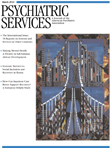Letter
Weighing the Evidence for Pediatric Antipsychotic Use
To the Editor: In the February Taking Issue commentary, Dr. Zima ( 1 ) warned that the results of our study about evidence-based prescription of second-generation antipsychotics to children ( 2 ) should be interpreted cautiously and perhaps are premature, given that clinical studies are ongoing. Furthermore, she suggested that clinicians and researchers keep the "blindfold" off when they attempt to find the balance between evaluating evidence and using it in clinical decision making.
We agree that the blindfold should be kept off, but let's not stand like a statue, either. It is important to learn how second-generation antipsychotics are used among children and to understand more about the risks and benefits of these drug products. The study was initiated in 2006, when none of the second-generation antipsychotics were approved by the Food and Drug Administration (FDA) for any indication in the pediatric population. However, the number of children taking these medications was already increasing significantly in 2006. Thus we believe that the study was not premature. Because more and more children were receiving these products, it was important that we begin to understand the utilization of second-generation antipsychotics in the pediatric population.
We recognize that there is a temporal nature of shifting evidence and that these results will change as more evidence is generated. Four second-generation antipsychotics are now approved by the FDA for specific indications in pediatric populations. However, even with the growing body of evidence, information is still limited. Other published studies have highlighted the increased use, safety issues, and unknown long-term effects of using these drugs to treat children ( 3 , 4 ). There have been calls for systematic monitoring protocols to address some of the questions surrounding their use in the pediatric population ( 5 ).
As Dr. Zima states, there are limitations to our study. Specifically, we did not have access to patients' medical records and could not determine the clinical decision making used to prescribe these products. Thus our linkage of the diagnosis to a prescription claim was limited. To mitigate this limitation, we used a broad two-year time frame around the index second-generation antipsychotic prescription to document diagnoses. This long time frame may have increased the likelihood of detecting any potential evidence-based diagnoses. However, without access to patients' medical charts, we cannot account for diagnoses not documented in the payment records. In addition, we agree with Dr. Zima that determining evidence-based use is not an exact science. But even when prescriptions based on "weak" evidence are excluded, 43% of use was not evidence based. This finding demonstrates the need for further research, perhaps by evaluating medical charts or conducting provider interviews, to better understand clinical decision making and the risks and benefits of using these drugs to treat children.
Should we prescribe first and ask questions later? Problems may occur when prescribing gets in front of the evidence. Clinicians need data to support their decision making about using second-generation antipsychotics for appropriate conditions in the pediatric population. Use of these medications to treat children should be based on evidence as well as clinical judgment. We owe it to the children we treat. So let's keep the blindfold off and keep asking questions and searching for answers.
1. Zima BT: Weighing scientific evidence: let's keep the blindfold off. Psychiatric Services 61:107, 2010Google Scholar
2. Pathak P, West D, Martin BC, et al: Evidence-based use of second-generation antipsychotics in a state Medicaid pediatric population, 2001–2005. Psychiatric Services 61:123–129, 2010Google Scholar
3. Correll C: Assessing and maximizing the safety and tolerability of antipsychotics used in the treatment of children and adolescents. Journal of Clinical Psychiatry 69(suppl 4):26–36, 2008Google Scholar
4. Olfson M, Blanco C, Liu L, et al: National trends in the outpatient treatment of children and adolescents with antipsychotic drugs. Archives of General Psychiatry 63:679–685, 2006Google Scholar
5. Rani FA, Byrne PJ, Murray ML, et al: Pediatric Atypical Antipsychotic Monitoring Safety (PAMS) study: pilot study in children and adolescents in secondary and tertiary care settings. Drug Safety 32:325–333, 2009Google Scholar



